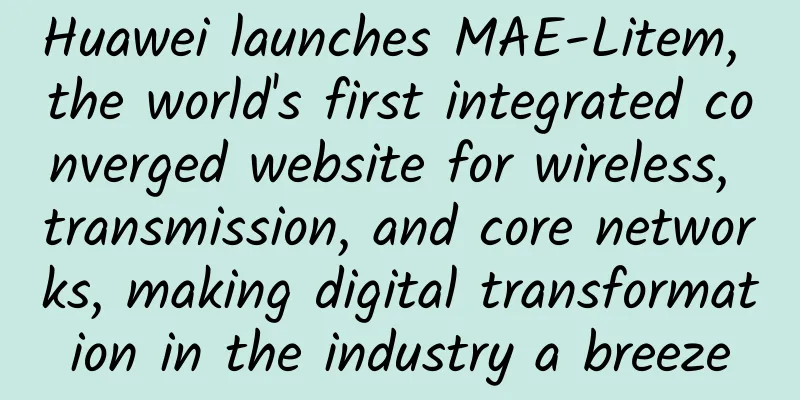5G industry enters a fast-forward period, and the three major operators have their own unique layouts

|
As the construction of 5G networks continues to accelerate, a variety of new applications and products are constantly being launched. 5G networks not only bring a network environment with high speed, large bandwidth, low latency, high reliability, low power consumption and large connections, but also help transform traditional industrial manufacturing and enable massive machine communications to achieve "everything is connected". It can be foreseen that 5G applications will optimize the network experience and speed up and increase the efficiency of industrial development. With the three major operators planning to pre-commercialize in 2019 and officially commercialize in 2020, the full application of 5G networks is just around the corner. At the third 5G Innovation and Development Summit Forum held recently, the results of the third phase of China's 5G technology research and development experiments were released. my country's third phase NSA (non-independent networking) tests have been completed, and SA (independent networking) tests have also been fully launched. "5G must not only be built well, but also used well." Wen Ku, director of the Information and Communications Development Department of the Ministry of Industry and Information Technology, said that it is necessary to accelerate the maturity of the 5G industry, organize 5G technology research and development trials and large-scale trials in an orderly manner, and strive to build a complete 5G industrial chain. 5G applications are not just about speed "Give me a reason to use 5G!" This was the thought of 30-year-old Lv Hongqiao before entering the 2018 China International Information and Communication Exhibition. Just half an hour later, he was having a blast and shouted "5G, come on!" At the Huawei booth, Lv Hongqiao put on a virtual reality helmet, held two controllers, and entered the battle game scene. To outsiders, he dodged left and right for no apparent reason. In fact, in his virtual world, enemies were pouring in from all directions... "Without the 5G network environment, the content would not be so clear, and the movements would not be so smooth." Huawei staff member Gu Jia said that Huawei's 5G virtual reality business has put the content in the cloud, and users can increase the comfort of the experience without having to buy a whole set of equipment. In addition to games, 5G virtual reality will also be used in the fields of medical care, education, etc. This is due to the three major features of 5G, namely high speed and large bandwidth, low latency and high reliability, and low power consumption and large connection. Among them, high speed and large bandwidth is what everyone understands as "fast". For a remote medical operation being carried out or an unmanned car on the road, a low latency and high reliability network environment is very important. "Low power consumption and large connectivity are truly closely related to ordinary people. It is with this attribute that massive machine communications can realize the 'connection of all things'. Innovative applications such as smart homes that are difficult to meet with 4G will become possible." said Wang Bin, senior analyst at Zhongcheng Think Tank. At the 2018 China International Information and Communication Exhibition, visitors at the China Unicom booth were queuing up to experience "5G immersive skiing". The screen in front of them was a ski slope. The audience standing on the experience machine held the long handles on both sides and tilted left and right from time to time, feeling like they were really skiing. At the China Telecom booth, when you hold the handle on one side of the booth and turn it, the robotic arm on the other side will work precisely on the circuit board according to your gestures. Although the smart life experience brought by 5G is always the most popular at the communication exhibition, Wang Bin believes that the most promising application area of 5G in the future should be smart manufacturing. Because the main development direction of the current manufacturing industry is lean production, digitalization, workflow and production flexibility, mobile operators can help manufacturers and logistics centers achieve smart manufacturing transformation. 5G network slicing and MEC (mobile edge computing) enable mobile operators to provide various value-added services and manage a large number of devices using remote control centers and data flow management tools. Three major scenarios are implemented simultaneously As Lu Yong, President of Huawei China, said, the development of 5G should focus on industry integration and accelerate the integrated development of 5G and vertical industries, rather than waiting for 5G to mature. From the perspective of 5G's sub-industries, "the Internet of Vehicles, the Internet of Things, and smart terminals represented by virtual reality devices and smartphones will be the three main application scenarios for the development of 5G," said Li Zhen, senior analyst at the Information and Communication Industry Research Center of CCID Consulting. At present, the field most closely related to 5G is the Internet of Things, and 5G is an indispensable communication technology for the development of the Internet of Things. 5G technology has the characteristics of wide coverage and open architecture, which can change the traditional network connection and give birth to the "Internet of Everything" between people, people and things, and things and things. Wang Bin believes that from the application level of the Internet of Things, the current 4G technology cannot meet the requirements of multi-point access, and its speed and anti-interference performance cannot be compared with 5G. It can be said that without 5G, the Internet of Things will be difficult to develop. At present, the Internet of Things industry is in a stage of sustained growth. Major domestic operators are actively deploying the Internet of Things and establishing Internet of Things research and testing platforms. CCID Consulting predicts that from 2020 to 2025, the total number of Internet of Things connections directly driven by 5G will reach 12.45 billion yuan. "5G technology has the characteristics of high speed and low latency, which provides a favorable foundation for intelligent connected vehicles. These related technologies of 5G can promote the upgrading of corresponding technologies such as autonomous driving, V2V (virtualization migration technology) and ADAS (advanced driver assistance system). Vehicle networking technology will become more mature and popular in the future, its market share will continue to increase, and the industry outlook will be more optimistic." Li Zhen predicts that from 2020 to 2025, the number of intelligent connected vehicles directly driven by 5G will reach 130 million. Similarly, the low latency feature of 5G can effectively improve the virtual reality experience and allow users to enjoy better audio-visual experience. At present, the manufacturing technology of virtual reality equipment is constantly upgrading, and equipment that better meets consumer needs is emerging in an endless stream. According to statistics, the shipment volume of VR/AR headsets in 2017 was 1.638 million units, a year-on-year increase of 98.3%. CCID Consulting predicts that the shipment volume of headsets will exceed 10 million units in 2021 and will approach 23.5 million units in 2025, of which 5G will directly drive the shipment volume of more than 7.5 million units, and there is huge room for hardware output value. It is estimated that from 2020 to 2025, the shipment volume of VR/AR devices directly driven by 5G will reach a total of 23.562 million units. "As the most important carrier of mobile communication technology, 5G smartphones will definitely be the trend of the future." Li Zhen said that it is expected that the penetration rate of 5G mobile phones will reach 2% in 2020, 30% in 2022, and 75% in 2024, and the cumulative shipments of 5G mobile phones will reach 325 million units. The industry is entering a fast-forward period Li Zhen believes that with the completion of the formulation of the latest version of the 5G standard, the industry's forecasts for the 5G market size and sub-sectors are more optimistic, and 5G will develop rapidly and reach its peak. Wang Bin said that my country's 5G industry has entered a stage of rapid advancement, forming a development trend of "the three major operators have basically completed their layout, the main equipment has a large leading advantage, and the terminal manufacturers' technology is basically the same." It is expected to achieve an output value of US$984 billion by 2035 and bring 9.5 million jobs. As of the end of 2017, my country has completed the 5G key technology test (Phase I) and 5G technical solution verification (Phase II), and officially launched the third phase of 5G system verification testing. According to Wang Bin, the first phase of key technology verification testing launched in January 2016 achieved results mainly in wireless technology, including large-scale antennas, new multiple access, new multi-carrier, advanced coding, ultra-dense networking, high-frequency communication and other key technology tests. The second phase of testing began in September 2016, focusing on laboratory and field performance functions and RF testing of 5G new air interface technology solutions, and verifying the service-oriented architecture, 5G main business processes and key points in network technology. The third phase will follow the unified international standards for 5G and focus on the single-site networking performance of pre-commercial equipment and related interconnection and interoperability tests based on commercial hardware platforms. Currently, operators have teamed up with telecommunications equipment companies to carry out large-scale field tests for different application scenarios in some cities. Currently, China's three major operators have completed 5G technology-related indoor and outdoor tests in 20 first-batch pilot cities including Beijing, Shanghai, Hangzhou, Shenzhen, and Guangzhou. The establishment of 5G complete networking standards indicates that 5G technology has entered the industrial planning stage. "The three major operators have their own pace in 5G layout. Among them, China Mobile deployed 5G the earliest, China Unicom deployed 5G a little more cautiously, and China Telecom's 5G layout strives to catch up after the competition." Li Zhen believes that under the country's policy of vigorously promoting the development of 5G, the three major operators will not be too far apart on the road to 5G commercialization, and the timeline will be relatively consistent, that is, they will all be pre-commercialized in 2019 and officially commercialized in 2020. It is understood that China Mobile has chosen to conduct 5G field tests in five cities, namely Hangzhou, Shanghai, Guangzhou, Suzhou and Wuhan. More than 100 5G base stations will be built in each city. 5G business and application demonstrations will also be carried out in 12 cities including Beijing, Chengdu and Shenzhen. Based on the launch of 5G innovation demonstration networks in six cities in 2017, China Telecom will continue to expand the scale of the test to 17 cities in 2018. China Unicom is conducting 5G pilot tests in 16 major cities across the country. Li Zhen analyzed that the regional deployment of the three major operators has different focuses and overlaps. China Mobile selected some cities in the southeastern coastal areas as the first trial cities for 5G technology; China Unicom mainly selected the Beijing area and a few cities in the Yangtze River Delta as the first batch of 5G trial cities; China Telecom's first batch of 6 cities were more scattered, distributed in the eastern coastal and central and western provinces, and no city clusters were formed. However, the three major operators all chose Shanghai as their first 5G pilot city, from which it can be inferred that Shanghai will become a "strategic fortress" for 5G key technologies. At the same time, the Beijing-surrounding area represented by Beijing and Xiong'an, the Yangtze River Delta represented by Shanghai, Suzhou and Hangzhou, and the Pearl River Delta represented by Guangzhou, Shenzhen and Zhuhai will become the key layout areas of the three major operators due to their relatively complete 5G infrastructure. |
<<: What? 5G early packages are released
>>: Wi-Fi Alliance announces Wi-Fi 6 as new logo
Recommend
How can IT operation and maintenance service providers keep WannaCry out? Hengyuan Zhicheng said that security needs to be prevented
[51CTO.com original article] It has been a week s...
"Hyper-converged Data Center Network Lossless Ethernet Scenario Level Evaluation Specification" released, Huawei is the first to complete the evaluation
The "2021 Open Data Center Summit" was ...
15% off on KVMLA dedicated servers, starting from 765 yuan per month for Japan/Singapore servers, top up 500 yuan and get 100 yuan free
In addition to the VPS hosting discount, KVMLA al...
What happens when SDN meets 5G?
SDN is a profound change to traditional IP networ...
GitHub requires two-factor authentication for all accounts!
GitHub has announced that before 2023, all develo...
CloudCone: Los Angeles CN2 GIA line server 15-100M unlimited traffic starting from $82/month
I have shared information about CloudCone many ti...
CloudCone: $9.5/year-512MB/30GB/3TB@1Gbps/Los Angeles data center
Updated again, CloudCone's Christmas promotio...
The Internet of Things has become a popular entry point for domestic operators’ eSIM technology
Apple phones have promoted the development of SIM...
High-quality networks build differentiated competitiveness for operators and enable business success
[Shenzhen, China, July 30, 2020] Today, Huawei he...
What should you do if you forget the wireless router backend login address?
If you want to modify the configuration of the wi...
There are four major challenges in the development of 5G. The next 2-3 years will be a critical period for the development of 5G.
A total of more than 700,000 5G base stations hav...
FreeWheel Diane Yu: Gather the best people to do the happiest things
[51CTO.com original article] This is not the firs...
VULTR adds 32nd data center in the world: Tel Aviv, Israel
In February this year, we shared the news that VU...
Do you really understand the network layer model?
I went for interviews throughout the summer and i...









